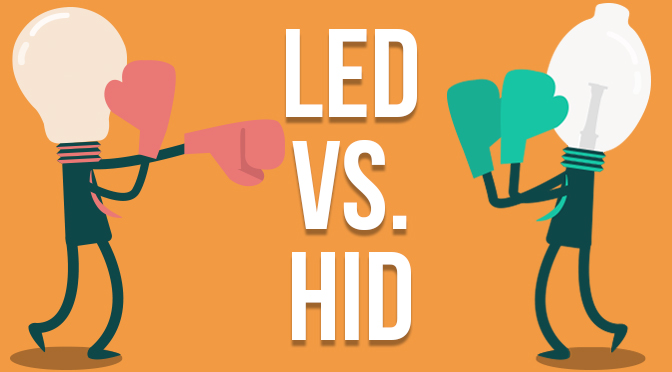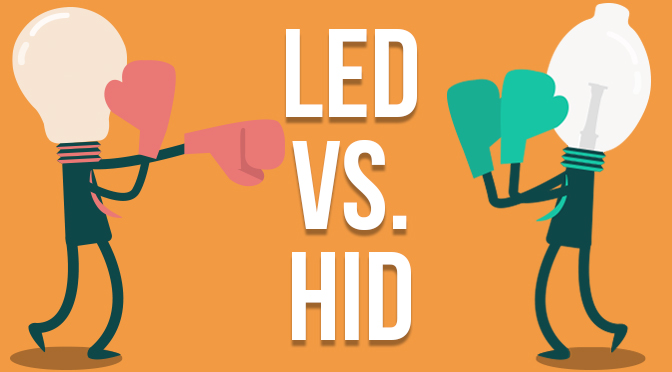
LED and HID lamps are two of the many lighting technologies that are available today. Knowing the difference between HID and LED can help you make an educated decision on what’s best for your application and budget.
HID and LED Comparisons
Left to right: differences in output and color rendition of mercury-vapor, metal-halide, high-pressure sodium, and LED high-bay lights for use in typical HID applications
HID (High Intensity Discharge):
HID lamps consist of a ballast and a quartz tube that contains gas, metal salts, and two tungsten electrodes. The ballast controls the voltage and current necessary to operate the lamp.
LED vs HID – An HID fixture and an HID replacement bulb
An HID fixture and a metal-halide HID replacement bulb
An electric arc passes from one electrode to the other through a gas (most commonly mercury, metal halide, or sodium). The arc heats metal salts and vaporizes them—creating a plasma—which increases light output created by the arc and increases efficiency.
Types of HID Lamps
Mercury-Vapor:
This type of lamp creates an electric arc through vaporized mercury that produces a bluish-green light. An outer bulb envelope insulates the bulb and protects against ultraviolet radiation. Mercury-vapor lamps are the oldest type of HID lighting and are being phased out because of the increased efficiency and better color rendition of metal-halide lights.
Metal-Halide:
Much like mercury-vapor lamps, metal halides have an electric arc that is created through vaporized mercury. However, metal halides (such as sodium, indium, and thallium) are added to increase efficiency and improve the light’s color-rendering index (CRI). An outer bulb envelope insulates the bulb and protects against ultraviolet radiation.
High-Pressure Sodium:
This type of HID lamp uses mercury vapors and sodium to ignite an electric arc, which produces a gold-colored light that is used mostly in parking garages.
Considerations:
HID bulbs are used for many applications, including warehouses, parking garages, outdoor stadiums, street lights, and headlights.
They produce a substantial amount of ultraviolet (UV) radiation that can be damaging to skin, eyes, and fabric.
Due to the large amount of energy that passes through it, the ballast necessary for creating the arc often wears out quickly.
HID bulbs and fixtures can last up to 20,000 hours but will often start to lose color and brightness long before that. To protect the ballasts, it is recommended that bulbs be replaced when they’ve reached 70 percent of their life span.
They last at least three times longer and are three times brighter than halogen bulbs, but their life spans are three times shorter than LED bulbs.
HID bulbs are fragile and contain mercury. They should be recycled, and bulb contents should be sealed if they are broken.
These lights can take anywhere from several seconds up to 10 minutes before they reach full brightness, and they need time to cool after being switched off before they can be turned on again.
They pose a risk for explosions and fires and can reach temperatures that make them unsafe to touch.
Shop Super Bright LEDs for solutions to retrofit old HID fixtures with more efficient, higher-performing LED bulbs.
Energy Consumed at Equivalent Light Output – LED vs HID
LED (Light Emitting Diodes):
LEDs produce the longest-lasting, most energy-efficient lighting available today. A semiconductor rich in electrons and a semiconductor rich in holes are used to create an LED.
LED Wall Pack and LED Corn Bulb – LED vs HID
LED wall pack and LED corn bulb
Passing a current through the junction of these two materials combines the electrons with the holes and produces photons, which is the light that you see.
Considerations:
LEDs run much cooler than HID bulbs and don’t require high running temperatures to work properly, which greatly increases their longevity and enables them to function in cold temperatures.
Unless an LED light is specifically infrared (IR) or ultraviolet (UV), it produces little to no IR or UV radiation, which can be damaging to skin, eyes, and fabrics.
They can last up to 50,000 hours—three times longer than HID bulbs and fixtures.
Power consumption is the lowest compared to all other lighting technologies—80 percent less than HID bulbs.
LED lights contain no mercury, harmful gasses, or toxins.
Many of these bulbs are shatterproof and shock resistant.
They illuminate instantly unlike HID bulbs that can take several minutes to reach full brightness.
LED lights require higher initial investment but are the best value due to energy savings and longer life spans.
They are available in many different colors and variations of white.
Because of their low power consumption, LED lights are great alternative lighting solutions for solar-powered systems.
To remove the hassle of bulb replacement, Super Bright LEDs also offers many fixtures with LEDs integrated into the fixture. Shop thousands of LED lighting solutions at OmaiLighting.com now
